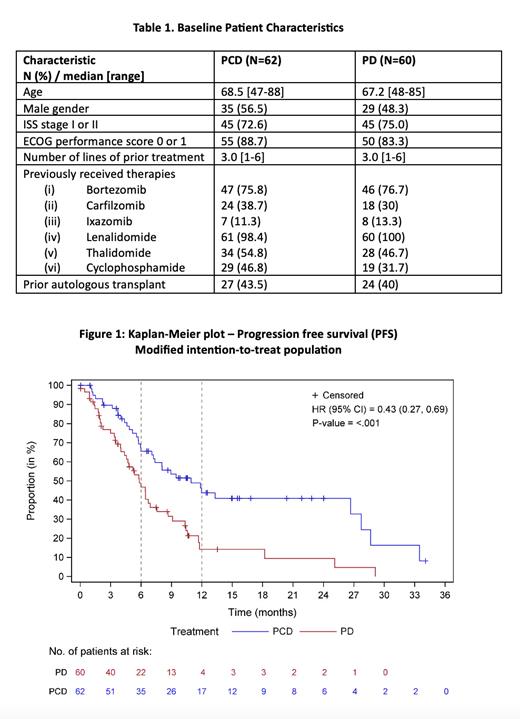Introduction
Patients with multiple myeloma (MM) who relapse or are refractory to (RRMM) lenalidomide and bortezomib have survival of less than 1 year. Pomalidomide (pom) is an immunomodulatory drug shown to improve survival in this group of patients 1. Optimal drugs to combine pom with are not known; patients tend to be triple class refractory by the time they require pom. We aim to compare pom, cyclophosphamide and dexamethasone (PCD) with pom and dexamethasone (PD) in Asian patients with RRMM 2.
Methods
This was a randomized, two arm, multicentre, multinational, prospective phase 3 study. RRMM patients with prior exposure to proteasome inhibitor (bortezomib, carfilzomib or ixazomib) and lenalidomide were recruited. Other inclusion criteria were: measurable disease, Eastern Cooperative Oncology Group (ECOG) performance status ≤2, satisfactory organ function (neutrophil count ≥ 1 000/mm 3, platelet ≥ 50 000/mm 3, bilirubin ≤ 1.5 x upper limit of the normal range (ULN), alanine aminotransferase and aspartate aminotransferase ≤ 3 x ULN and creatinine clearance ≥ 30ml/min). Patients with plasma cell leukaemia, > 6 lines of treatment or prior exposure to pom were excluded.
Patients were randomized in a 1:1 ratio to receive PCD or PD. Dosing schedule was 4-weekly: pom 4mg day 1 - 21, dexamethasone 40mg twice a week and, for patients on PCD, cyclophosphamide 400mg weekly for 3 weeks. Patients received treatment until disease progression, unacceptable toxicity determined by treating physician, consent withdrawal or death. A modified intention-to-treat population was used for analysis, which included all randomized patients receiving at least 1 dose of study drug.
Primary endpoint was progression free survival (PFS), defined as time from start of treatment to disease progression or death from any cause. Secondary endpoints were overall response rate (ORR, percentage of patients achieving partial response (PR) or better), overall survival (OS), duration of response (DOR, time from first evidence of PR or better till disease progression or death, whichever occurred first) and safety, assessed by frequency and percentage of adverse events by severity. PFS, OS and DOR were presented using Kaplan-Meier curves. Comparison between 2 arms was performed by Cox proportional hazard model for PFS, OS and DOR, using generalized linear model with binomial distribution for ORR.
Results
124 patients were recruited, of whom 122 received at least 1 dose of study drug (62 PCD, 60 PD). Baseline characteristics were comparable between treatment arms (Table 1). Median age was 68.5 (range 47 - 88) years in the PCD arm; 67.2 (range 48 - 85) years in the PD arm. Patients in both arms received median of 3 (range 1-6) prior lines of treatment.
At a median follow-up of 13.5 (IQR 8.7 - 24.0) months, median PFS was 10.9 months (95% CI, 7.1 - 27.7) in the PCD arm versus 5.8 months (95% CI, 4.4 - 6.9) in the PD arm (hazard ratio (HR) 0.43, 95% CI, 0.27-0.69); p < 0.001). ORR was 55.4% (95% CI, 41.0 - 69.7) in the PCD arm and 32.0% (95% CI, 19.5 - 44.5) in the PD arm; difference 23.3% (95% CI, 6.5 - 40.2, p = 0.007). Median DOR was 12.0 months (95% CI, 7.2 - not reached, NR) in the PCD arm and 5.7 months (95% CI, 3.7 - 9.7) in the PD arm (HR 0.41, 95% CI, 0.20 - 0.87). Although not statistically significant, median OS was numerically greater in the PCD arm (41.5 months, 95% CI, 24.5 - NR) in comparison with the PD arm (27.5 months, 95% CI, 27.5 - NR).
Median treatment duration for pom was 7.8 (IQR 4.4 - 13.4) months in the PCD arm and 5.1 (IQR 2.8 - 8.7) months in the PD arm. Adverse events rates were similar in both arms. 51 patients (82.3%) in the PCD arm had 346 treatment emergent adverse events (TEAEs); 164 (47.4%) relating to study treatment. 49 patients (81.7%) in the PD arm had 241 TEAEs; 136 (56.4%) relating to study treatment. Most common grade 3/4 TEAEs in both arms were neutropaenia, anaemia and pneumonia. 34 deaths occurred during the study (17 PCD, 17 PD), 12 (35.2%) were due to disease progression. 3 (1 PCD, 2 PD) were deemed to be related to study treatment (2 infections, 1 fluid overload).
Conclusion
This study demonstrated that PCD significantly prolonged PFS, improved ORR, and DOR over PD in patients with RRMM and previous exposure to a proteasome inhibitor and lenalidomide. PCD treatment presents a therapeutic option in this population of patients, with acceptable and manageable safety profile.
References
1. Miguel JS et al. Lancet Oncol. 2013;14:1055
2. Rachid CB et al. Blood 2016;127: 2561
Disclosures
Handa:BMS: Other: Grants; Kyowa Kirin: Other: Grants; Takeda: Consultancy, Honoraria, Other: Grants; Ono: Consultancy, Honoraria; Janssen: Consultancy, Honoraria.


